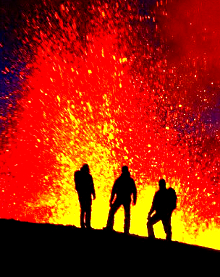Drilling for liquid heat steams up in Iceland
 Iceland is going deep for its next new energy supply - drilling a 2.1 kilometre hole through the Earth’s crust to draw power from its liquid interior.
Iceland is going deep for its next new energy supply - drilling a 2.1 kilometre hole through the Earth’s crust to draw power from its liquid interior.
Iceland's National Energy Authority has created the world's first magma-based geothermal energy system.
It has been created by the literally ground-breaking work of the Iceland Deep Drilling Project (IDDP), a gathering of the National Energy Authority of Iceland and various leading energy companies.
To get down to the really hot stuff, the IDDP bored down near a volcanic crater at Krafla, in northeast Iceland.
The 2.1 kilometre hole was lined with steel to create a shaft supplying super-heated steam (at about 450 degrees Celsius) to a nearby power plant.
The project has broken world records for geothermal heat and power.
It is not yet fully operational however, after a valve failure meant the hole to the magma-powered steam pipe had to be closed.
IDDP plans to reopen of IDDP-1 (the Krafla site), as well as drill a second borehole (IDDP-2) in Reykjanes, Iceland shortly.
Getting power directly from magma has many advantages over other geothermal sources, the IDDP said in its reporting documents.
“In various parts of the world so-called EGS geothermal systems ... are being created by pumping cold water into hot dry rocks at 4 to 5 km depths. Then the heated water is taken up again as hot water or steam from nearby production wells. In recent decades, there has been considerable effort invested in Europe, Australia, USA, and Japan, with uneven results and typically poor results,” the IDDP stated.
“The success of this drilling and research is amazing to say the least, and could in the near future lead to a revolution in energy efficiency in high-temperature geothermal areas of the world.”
“What is the future and do the results have a practical value?” the IDDP asks.
“Sure, the future is bright and the answer is 'yes'. Although the IDDP-1 hole is unusable at the moment, in [the] future the aim is to drill a similar hole and/or to repair IDDP 1 hole,” it stated.
“The experiment at Krafla suffered various setbacks and tried personnel and equipment throughout. However, the process itself was very instructive, and... comprehensive reports on practical lessons learned are nearing completion.”








 Print
Print